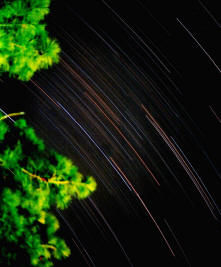Polar Alignment Guide for Singaporeans
Date:
29/07/2009
For those of us living in Singapore, we are, for
all practical purposes, on the equator. And as such, there is no way we can ever
"spot" the north star to help us with polar alignment. So drift alignment is
what most of us rely on. Here's a little tutorial on what this is all about.
Hope this helps !! And if you have suggestions to
improve this tutorial, please let
me know !!
Joo Beng
Here are the steps to understanding
this : 1) Understanding Polar
Alignment 2) What's different about being
in Singapore 3) How does Drift Alignment
work 4) What equipment is needed
5) What are the steps to Drift Alignment
Advanced topics :
6) Other methods of alignment
7) Mathematical approach to alignment
|
Step 1 Understanding Polar Alignment |
|
WHAT |
WHY |
|
Polar alignment is primarily for astrophotography.

|
Light from deep sky objects are very faint, so to take a picture of them
through a telescope, you need to keep your shutter open for a long time.
Instead of the usual fraction of a second with normal cameras, think of
10 seconds to 10 hours ! |
|
While looking at a star through a telescope for 10 seconds, you'll
notice that the star will "move" or drift. Here's a photo of
the night sky that is exposed for several minutes - you'll notice that
the star forms "trails" of light.
 |
Actually, it's not the star that is moving, but instead, it's you that
is moving. You are on the Earth, which is always rotating. (By the way,
this is why the Sun "rises" - the Sun doesn't really "rise", it just
looks like it does.) |
|
So Polar Alignment is all about cancelling, or counter-rotating, the
Earth's rotation.
|
As the Earth rotates one way, your telescope + camera must rotate in the
opposite direction, so that the target you are trying to photograph,
stays in the exact same place. |
|
You do this by lining up the axis of rotation of your equipment with
that of the Earth. Both axes must be exactly parallel. |
Since stars or other deep sky objects are very very far
away, they can be considered at infinity. So as long as the axes are
parallel, a deep sky target will appear stationary. |
|
When the axes are parallel, your equipment is polar aligned. |
When your axis is aligned with the Earth, one end of the
axis points north, and the other points south. Aligned with the North
and South Pole. Hence the term Polar Alignment. |
|
To get your axis parallel, basically, you will need to point the axis
north, and incline it above the horizontal position by the lattitude of
your location. Singapore's lattitude is |
If you look at the geometry involved, it just so happens
that your lattitude is the same as the number of degrees up that is
needed. |
|
Now all you need to do, is to turn, or drive your axis at the exact same
angular speed as the Earth's rotation, but in the opposite direction. |
For a computerised mount, the computer will control the
speed. For non-computerised mounts, this can be accomplished using
either single or dual-axis motor drives. |
|
Step 2 What's the problem in Singapore |
|
WHAT |
WHY |
|
We are practically on the Equator. So we can't use the "normal" method
of polar aligning on the North Star. |
The North Star just so happens to be almost on the North-South axis so
it's a great aid in aligning telescopes.
Polar alignment in the Northern lattitudes (e.g. USA) can align their
equipment using the North Star. They can see the the North Star from
where they are. Equipment that we buy are typically made for the
northern hemisphere (US, Europe, China).
But...near the equator, we can't
see the North Star ! It's "hidden" by the horizon - we are only able to
"see" stars that are greater than 5 above the horizon due to constraints
like atmosphere and geometry. |
|
You can do a "rough" polar alignment using a compass. This is
normally accurate enough for low power magniciation and for visual (as
opposed to photographic) use. |
The compass points North/South, but this isn't always the exact same
direction as the true north/south axis of rotation. The difference is
called the magnetic declination, and varies by location on the earth.
For Singapore, this "offset" is practically negligible, so using the
magnetic north/south will do. |
|
For higher powers of magnification, the rough alignment can be
frustrating since the target object will "drift" out of view relatively
quickly. |
Field of View
(FOV) is the angular amount that you can "see" at any given instant. FoV
of normal unassisted human vision is about 60°.
With higher magnification, things further away appear larger, and the
effective FoV is also correspondingly decreased.
With high magnification (say about 150x), the FOV is reduced to about
0.5° or less.
The Earth rotates 15° per hour, which is
0.25° per minute. So if you are not correctly
aligned, your target can easily "drift" out of your FOV in a minute or
less ! |
|
Also for photographic use, any "drifting" of the target object
(especially dim objects which require long exposures) is unacceptable as
it will create a streak of light. |
With digital photography, a CCD sensor comes in varying "resolutions" -
e.g. the Meade DSI II has a resolution of 752x582. For convenience let's
use 1000x1000. If the FOV of the telescope+CCD is 0.5°,
then each pixel of the CCD "sees" only 0.0005°
!! If you aren't able to hold your image steady enough during your
exposure you will get "blurry" or less-than-sharp images. |
|
So without the pole star, the only other way to accurately align your
telescope is via a method called Drift Alignment |
|
|
Step 3 How does Drift Alignment work |
|
WHAT |
WHY |
|
|
|
|
|
|
|
|
|
|
|
|
|
|
|
|

